Powitanie w zamku w Krasiczynie
(07.04.2011)
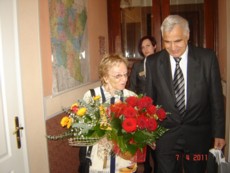
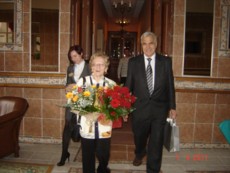
Spacer po Przemyslu
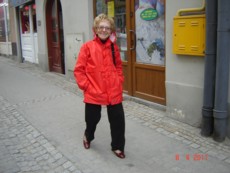
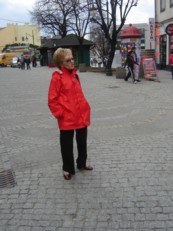
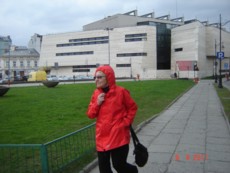

Powitanie w gimnazjum w Krasiczynie
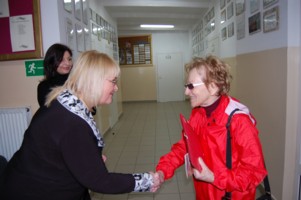
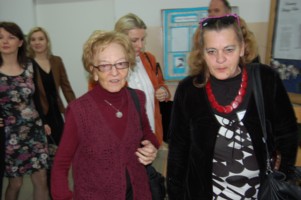
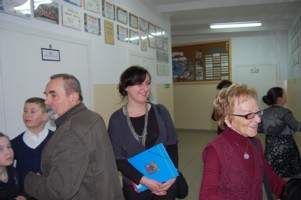
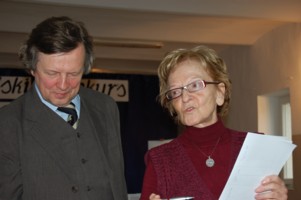
Przesłuchania
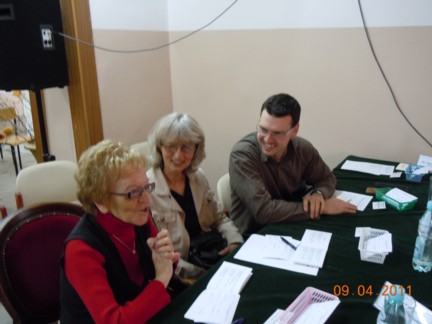
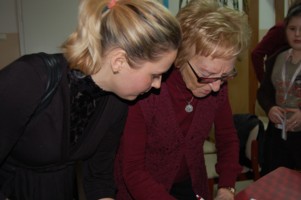
Kolacja w "Impresji"
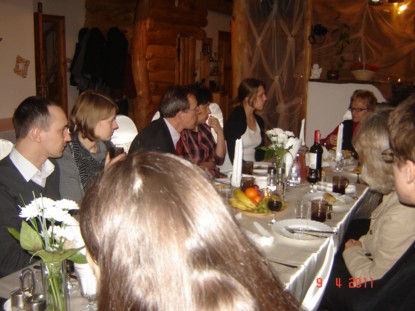
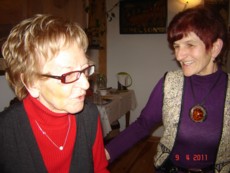
Konsultacje
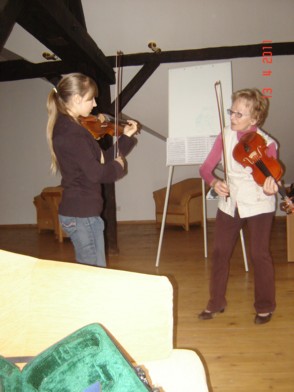
Zwiedzanie zamku
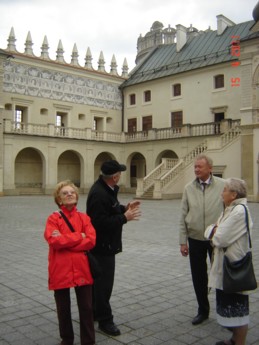
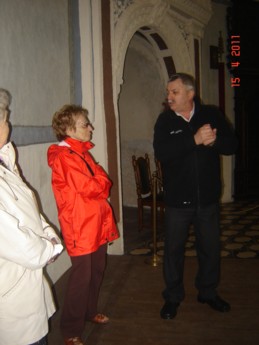
Po konkursie
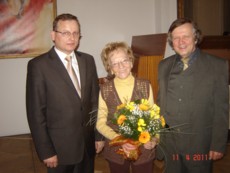
Pożegnanie na lotnisku
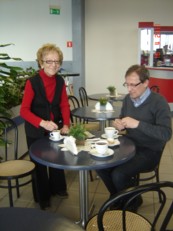
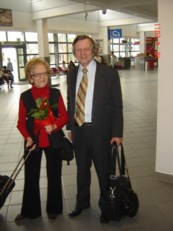
|
prof. Wanda Wiłkomirska
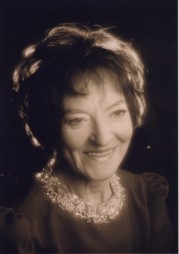


|
Wanda Wiłkomirska - wybitna i najbardziej znana na świecie polska skrzypaczka - pochodzi z cenionej rodziny muzycznej. Swoje pierwsze kroki w skrzypcowej edukacji stawiała pod kierunkiem ojca. Odbywała studia muzyczne, które zwieńczyła dyplomami PWSM - w Łodzi u Ireny Dubiskiej (1947) i Akademii im. Ferenca Liszta w Budapeszcie u Ede Zathureczkiego (1950). Swój kunszt wiolinistyczny doskonaliła u Henryka Szerynga w Paryżu i w Warszawie u Tadeusza Wrońskiego, u którego przygotowywała się do Konkursu im. Henryka Wieniawskiego w Poznaniu.
Skrzypaczka jest laureatką konkursu w Genewie (1946), Budapeszcie (1949), Lipsku (1950) i Poznaniu (1952). Sukcesy konkursowe, a także udane występy z Filharmonią Warszawską przyniosły artystce duży rozgłos w kraju i za granicą. Szczególnie ważny dla Jej kariery okazał się "muzyczny mariaż" z Witoldem Rowickim - wybitnym dyrygentem i współtwórcą Filharmonii Narodowej. W 1955 roku Wanda Wiłkomirska grała na inauguracji odbudowanej Filharmonii przy ulicy Jasnej w Warszawie.
W tym samym roku otrzymała status solistki tej orkiestry i wraz z takimi mistrzami batuty jak W. Rowicki, S. Wisłocki, A. Wit koncertowała na wielu estradach świata. Przełomowym momentem w Jej karierze był występ w słynnej nowojorskiej Carnegie Hall, gdzie w 1961 roku wraz z orkiestrą FN pod dyrekcją W. Rowickiego wykonała I Koncert Karola Szymanowskiego. Jej talent zauważył najsłynniejszy wówczas muzyczny impresario amerykański Sol Hurok (manager takich sław jak I. Stern i D. Ojstrach), który otworzył przed skrzypaczką drzwi chłonnego rynku amerykańskiego i kanadyjskiego. Od tej pory artystka rokrocznie gościła za Atlantykiem, grając recitale i koncerty symfoniczne, a w 1968 nawiązała stałą współpracę z płytową firmą Connoisseur Society w Nowym Jorku, dla której nagrała 12 płyt. Dwie z nich otrzymały nagrody "Best of the Year" (1972) i Grand Prix du Disque (1974). Wanda Wiłkomirska współpracowała również z największymi firmami fonograficznymi, takimi jak: Deutsche Grammophon, EMI, Philips, Naxos i inne. Nagrywała również dla Polskich Nagrań.
W 1969 roku na mapie Jej skrzypcowych podbojów pojawiła się Australia, gdzie artystka odbyła swoje pierwsze tournée z 37 koncertami. Jej gra zyskała wielkie uznanie i skrzypaczka otrzymała dalsze propozycje recitali i koncertów z australijskimi orkiestrami symfonicznymi. W roku 1973 wystąpiła jako pierwsza solistka z recitalem skrzypcowym w nowo wybudowanej Operze w Sydney.
Występowała z recitalami i koncertami symfonicznymi w największych salach koncertowych, takich jak: Carnegie Hall, Lincoln Center, Salle Pleyel w Paryżu, Gewandhaus, Royal Festival Hall, Sala im. P. Czajkowskiego w Moskwie, czy Sala Filharmonii Berlińskiej. Współpracowała m. in. z New York Philharmonic, Cleveland Orchestra, Hallé Orchestra, Royal Philharmonic, Sydney Symphony, Gewandhausorchester Leipzig, Scottish Chamber Orchestra, Royal Concertgebouw Orchestra, Berliner Philharmoniker, pod batutą takich znakomitości, jak: Paul Klecki, Pierre Boulez, Paul Hindemith, Leonard Bernstein, Otto Klemperer, Zubin Mehta, Sir John Barbirolli, Wolfgang Sawallisch, Kurt Masur, Erich Leinsdorf. Właśnie wspólnie z maestro Leinsdorfem Wanda Wiłkomirska wykonaniem Koncertu skrzypcowego B. Brittena zainaugurowała w 1976 roku otwarcie słynnej Barbican Hall w Londynie. W roku 1986, po obaleniu władzy apartheidu w Afryce Południowej, skrzypaczka przyjęła zaproszenie na koncerty w tym kraju, co zaowocowało nowymi kontraktami na kolejne sezony artystyczne. Odtąd nazwisko Wandy Wiłkomirskiej znane było na wszystkich kontynentach - od Sydney po San Francisco i od Kapsztadu po Reykjavik.
Skrzypaczka współpracuje również z polskimi orkiestrami symfonicznymi. "Otwierała" inaugurującymi koncertami nowe sale filharmoniczne m. in. w Rzeszowie, Szczecinie, Wałbrzychu. Nie stroni od występów w małych miastach, co przysparza Jej rzeszy wielbicieli wśród melomanów.
Inną bardzo znaczącą działalnością skrzypaczki jest kameralistyka. Bardzo często koncertowała w trio fortepianowym, współtworzonym ze swoim rodzeństwem: pianistką Marią i wiolonczelistą Kazimierzem.
Jako kameralistka współpracowała również z takimi sławami jak: Krystian Zimerman, Gidon Kremer, Martha Argerich, Kim Kashkashian, Misha Maisky. Występowała m. in. na festiwalu "Bravo Maestro", Gidon Kremer & Friends w Kuhmo, Martha Argerich & Friends w Bochum.
Artystka jest często zapraszana do udziału w festiwalach muzycznych w Edynburgu, Wiedniu, Salzburgu, Paryżu i w Warszawie.
Bardzo ważne w Jej szerokiej działalności są prawykonania polskich kompozycji współczesnych. Do najważniejszych z nich należą premiery takich utworów jak: V Koncert skrzypcowy (1951) i VII Koncert skrzypcowy (1979) Grażyny Bacewicz, Ekspresje Tadeusza Bairda (1959), Dialogi Augustyna Blocha (1966), Capriccio Krzysztofa Pendereckiego (1968), Koncert skrzypcowy Zbigniewa Bargielskiego (1977), Koncert skrzypcowy Zbigniewa Bujarskiego (1980), Sonata Romana Maciejewskiego (1998), Koncert na skrzypce i orkiestrę Włodzimierza Kotońskiego (2000).
W roku 1982, w stanie wojennym, Wanda Wiłkomirska wyemigrowała z kraju i osiedliła się w Republice Federalnej Niemiec. W 1983 roku objęła stanowisko profesora w Heidelberg-Mannheim Hochschule für Musik. Odtąd nauczanie, jako dzielenie się z młodymi adeptami sztuki wiolinistycznej swoimi umiejętnościami warsztatowymi i muzycznym doświadczeniem, stało się wielką pasją artystyczną skrzypaczki.
Wanda Wiłkomirska często zasiada w jury konkursów skrzypcowych, m. in. w Moskwie, Tokio, Londynie, Monachium, Wiedniu, Grazu, Hannoverze, Gorizii, Poznaniu, Krakowie, Łodzi i Lublinie.
Po przejściu na emeryturę, ale jeszcze w pełni sił witalnych i koncertowych, Wanda Wiłkomirska przyjęła w 1999 roku posadę pedagoga w Sydney Conservatorium of Music. Z wielkim zaangażowaniem prowadzi również kursy mistrzowskie w Polsce, Japonii, Szwajcarii, Włoszech, Finlandii, Austrii, Niemczech i Australii.
Za swoją działalność artystyczną została odznaczona Nagrodą Państwową I i II stopnia, Krzyżem Komandorskim Orderu Odrodzenia Polski, Krzyżem Komandorskim z Gwiazdą, uhonorowana także orderem przez Polonię Australijską oraz nagrodzona przez Fundację im. Karola Szymanowskiego.
Wanda Wiłkomirska gra na skrzypcach Pietro Guarneriego wykonanych w 1734 roku w Wenecji.
POLSKIE NAGRANIA, 2006
Wanda Wiłkomirska, die bedeutendste und bekannteste polnische Geigerin, entstammt einer angesehenen Musikerfamilie. Den ersten Violinunterricht erhielt sie von ihrem Vater. Das Musikstudium schloss sie mit einem Diplom der Staatlichen Musikhochschule in Lodz in der Klasse von Prof. Irena Dubiska (1947) und der Ferenc Liszt-Akademie in Budapest in der Klasse von Ede Zathureczki (1950) ab. Um ihr Violinspiel zu vervollkommnen, setzte sie nach dem Studium ihre Ausbildung in Paris bei Henryk Szeryng und in Warschau bei Tadeusz Wroński fort; letzterer bereitete sie auf den Henryk Wieniawski-Wettbewerb in Posen vor.
W. Wiłkomirska ist Preisträgerin der Violinwettbewerbe in Genf (1946), Budapest (1949), Leipzig (1950) und Posen (1952). Die erfolgreiche Teilnahme an diesen Wettbewerben sowie Auftritte mit der Warschauer Philharmonie machten die Künstlerin in Polen und im Ausland bekannt. Von besonderer Bedeutung für ihre Karriere war die musikalische Verbindung zu dem Dirigenten Witold Rowicki, der die Warschauer Nationalphilharmonie entscheidend prägte. Im Jahre 1955 wurde Wanda Wiłkomirska zur Solistin des Orchesters ernannt. Zusammen mit Rowicki konzertierte sie auf vielen Bühnen der Welt. Einen Wendepunkt in ihrer Karriere stellte der Auftritt in der New Yorker Carnegie Hall dar, wo sie im Jahre 1961 zusammen mit dem Orchester der Nationalphilharmonie das Violinkonzert Nr. 1 von Karol Szymanowski spielte. Sol Hurock, damals der berühmteste Musikimpressario, der so namhafte Geiger wie I. Stern und D. Oistrach betreute, bemerkte die außergewöhnliche Begabung W. Wiłkomirskas und öffnete ihr die Tore zum amerikanischen und kanadischen Musikmarkt. Von nun an konzertierte sie jährlich in Amerika im Rahmen von Violinabenden und Philharmoniekonzerten. Im Jahre 1968 nahm sie eine ständige Zusammenarbeit mit der Plattenfirma Connoisseur Society in New York auf, für die sie 12 Platten einspielte, von denen zwei die Auszeichnung „Best of the Year“ (1972) und den „Grand Prix du Disque“(1974) erhielten. Seit jener Zeit arbeitet die Geigerin mit den größten Plattenfirmen wie Deutsche Grammophon, EMI, Philips, Naxos und Polskie Nagrania zusammen.
Im Jahre 1969 errang W. Wiłkomirska große künstlerische Erfolge in Australien. 1973 trat sie als erste Solistin in der Sydney Opera auf. Mit ihrem Spiel gewann sie große Anerkennung; die Geigerin wurde zu zahlreichen Violinabenden und Konzerten mit australischen Symphonieorchestern eingeladen. Seit Anfang der sechziger Jahre konzertiert sie in den bedeutendsten Konzertsälen der Welt, z.B. Carnegie Hall, Lincoln Center New York, Salle Pleyel in Paris, Gewandhaus zu Leipzig, Royal Festival Hall, Großer Saal des Tschaikowski-Konservatoriums Moskau, Berliner Philharmonie und Sydney Opera. Wanda Wilkomirska trat u. a. mit folgenden Orchestern auf: New York Philharmonic, Cleveland Orchestra, Halle Orchester, Royal Philharmonic, Sydney Symphony, Gewandhausorchester Leipzig, Scottish Chamber Orchestra, Royal Concertgebouw Orchester, Berliner Philharmoniker. Sie spielte unter der Leitung so berühmter Dirigenten wie Paul Klecki, Pierre Boulez, Paul Hindemith, Otto Klemperer, Zubin Mehta, Sir John Barbirolli, Wolfgang Sawallisch, Kurt Masur und Erich Leinsdorf. Unter der Leitung von Leinsdorf eröffnete sie 1976 mit einer Aufführung des Violinkonzerts von B. Britten die weltberühmte Barbican Hall in London. 1986, nachdem die institutionelle Apartheid in Südafrika abgeschafft worden war, nahm sie erstmals eine Einladung zu dortigen Konzerten an. Seitdem kann man sagen, Wanda Wilkomirska sei auf allen fünf Kontinenten bekannt. Trotz dieser Erfolge führte sie ihre Zusammenarbeit mit kleineren polnischen Orchestern und Philharmonien fort, wodurch sie immer wieder neue Fans unter den Musikliebhabern und in Musikerkreisen gewinnen konnte.
Die Kammermusik nimmt einen sehr wichtigen Platz in der musikalischen Tätigkeit der Geigerin ein, die in jungen Jahren mit ihrer Schwester Maria am Klavier und ihrem Bruder Kazimierz am Violoncello als "Trio Wilkomirski" auftrat. Als Kammermusikerin arbeitete sie auch mit so bekannten Musikern wie Krystian Zimerman, Gidon Kremer, Martha Argerich, Kim Kashkashin und Mischa Maisky zusammen. Sie trat u. a. bei den Festivals „Bravo Maestro“, "Gidon Kremer & Friends" in Kumho und "Martha Argerich & Friends" in Bochum auf. Mehrfach wurde die Künstlerin zur Teilnahme an Musikfestivals in Edinburg, Wien, Salzburg, Paris und Warschau eingeladen.
In ihrer Karriere spielen Uraufführungen polnischer zeitgenössischer Musikwerke eine große Rolle. Zu den wichtigsten Uraufführungen gehören Werke wie das Violinkonzert Nr. 5 (1951) und das Violinkonzert Nr. 7 (1979) von Grażyna Bacewicz, die Espressioni Varianti von Tadeusz Baird (1959), Dialoghi per violino e orchestra von Augustyn Bloch (1966), das Capriccio von Krzysztof Penderecki (1968), das Violinkonzert von Zbigniew Bargielski (1977), das Violinkonzert von Zbigniew Bujarski (1980), die Sonate von Roman Maciejewski (1998) und das Konzert für Violine und Orchester von Włodzimierz Kotoński (2000).
Im Jahre 1982, zur Zeit des Kriegsrechts, emigrierte Wanda Wiłkomirska und ließ sich in der Bundesrepublik Deutschland nieder. Im Jahre 1983 erhielt sie eine Professur an der Staatlichen Hochschule für Musik Heidelberg-Mannheim. Seitdem ist das Unterrichten eine große Leidenschaft der Geigerin.
Wanda Wiłkomirska ist häufig Jurymitglied bei Violinwettbewerben, u. a. in Moskau, Tokyo, London, München, Wien, Graz, Hannover, Gorizia, Lichtenberg, Posen, Lodz und Lublin.
Nachdem die Künstlerin in den Ruhestand getreten war, nahm sie, immer noch voller vitaler und musikalischer Kräfte, einen Lehrauftrag am Sydney Conservatorium of Music an. Sie gibt häufig Meisterkurse in Polen, Japan, der Schweiz, Italien, Finnland, Australien, Österreich und Deutschland.
Für ihre künstlerische Tätigkeit wurde sie mit dem Staatspreis 1. und 2. Klasse, dem Kommandeurskreuz des Ordens der Wiedergeburt Polens und dem Kommandeurskreuz mit Stern ausgezeichnet. Außerdem verliehen die australischen Auslandpolen der Geigerin einen Orden und die Karol Szymanowski-Stiftung eine Auszeichnung.
Wanda Wiłkomirska spielt auf einer Violine von Pietro Guarneri (Venedig) aus dem Jahre 1734.
POLSKIE NAGRANIA, 2006
Wanda Wiłkomirska, the outstanding and most famous of all Polish violinists, comes from a notable musical family. Indeed, the first steps in her learning violin were taken under the guidance of her father. Her violin studies resulted in her graduating in 1947 from the Łódź Academy of Music, where she studied under Irena Dubiska. This was followed by her graduation from the Ferenc Liszt Music Academy in Budapest in 1950, where she studied under Ede Zathureczki. She later perfected her violin technique in Paris under the guidance of Henryk Szeryng, and in Warsaw under Tadeusz Wroński, who assisted her in preparing for the Henryk Wieniawski Violin Competition in Poznań.
Wanda Wiłkomirksa went on to win prizes at competitions in Geneva (1946), Budapest (1949), Leipzig (1950) and Poznań (1952). Her success in these competitions, along with her splendid performances with the Warsaw Philharmonic brought her much acclaim in Poland and abroad. A significant moment in her career proved to be her "musical union" with Witold Rowicki – the prominent conductor and co-founder of Poland's National Philharmonic. In 1955, Wanda Wiłkomirska performed at the inauguration of the rebuilt Philharmonic concert hall on Warsaw's Jasna Street. That same year, she was awarded the status of that orchestra's soloist and gave many performances around the world with such conductors as W. Rowicki, S. Wisłocki and A. Wit. A turning point in her career was the 1961 performance, with the National Philharmonic Orchestra conducted by W. Rowicki, of Karol Szymanowski's Concerto No. 1 at New York's famous Carnegie Hall. Her talent came to the notice of the most famous American impresario of that time – Sol Hurok (manager of such stars as I. Stern and D. Oistrakh), who introduced her to the enthusiastic U.S. and Canadian markets. From that moment on, she would make regular annual visits to America to perform recitals and symphonic concerts. In 1968, she began regularly recording for the Connoisseur Society record company in New York, for which she made 12 albums. Two of these won awards, namely "Best of the Year" (1972) and the Grand Prix du Disque (1974). She has also recorded with the biggest phonographic companies, such as: Deutsche Grammophon, EMI, Philips and Naxos. Naturally, she has also recorded for Polskie Nagrania.
In 1969, Australia became another position on the map of her artistic conquests, when she toured that country for the first time, giving 37 performances. These interpretations won her great acclaim and she received further recital and concert proposals from Australian symphonic orchestras. In 1973, she was the first violinist to perform a solo recital in the newly built Sydney Opera House.
She has given recitals and performed symphonic concerts in probably all the most famous halls, including: Carnegie Hall, the Lincoln Center, Salle Pleyel in Paris, Gewandhaus, the Royal Festival Hall, the Piotr Tchaikovsky Hall in Moscow and the Berlin Philharmonic Hall. She has performed with the New York Philharmonic, the Cleveland Orchestra, the Hallé Orchestra, the Royal Philharmonic, the Sydney Symphony Orchestra, the Leipzig Gewandhausorchester, the Scottish Chamber Orchestra, the Royal Concertgebouw Orchestra and the Berliner Philharmoniker, with such celebrated conductors as: Paul Klecki, Pierre Boulez, Paul Hindemith, Leonard Bernstein, Otto Klemperer, Zubin Mehta, Sir John Barbirolli, Wolfgang Sawallisch, Kurt Masur and Erich Leinsdorf. Indeed, it was her performance of Benjamin Britten's Violin Concerto, conducted by Leinsdorf, which accompanied the 1976 inauguration of the famous Barbican Hall in London. In 1986, following the overthrow of apartheid, she accepted an invitation to perform in South Africa, this resulting in new contracts for upcoming seasons. From that point in time, her name has been known on all continents, from Sydney to San Francisco, from Capetown to Reykjavik.
Wanda Wiłkomirska has also worked with Polish symphonic orchestras, performing at the inauguration concerts of new philharmonic halls in Rzeszów, Szczecin and Wałbrzych. She is not one to shun performances in small towns, a fact that has won her a host of warm admirers among music lovers.
Another important artistic activity is her chamber music. She has often performed in a piano trio, accompanied by her sister Maria at the piano and her brother Kazimierz on the cello. As a chamber musician she has also played with such stars as Krystian Zimerman, Gidon Kremer, Martha Argerich, Kim Kashkashian and Misha Maisky. She has performed at such festivals as: "Bravo Maestro", Gidon Kremer & Friends in Kuhmo, and Martha Argerich & Friends in Bochum.
The artist is often invited to take part in music festivals in Edinburgh, Vienna, Salzburg, Paris and Warsaw.
Among the broad range of her activities, a very important role is played by her premiere performances of Polish contemporary compositions. The most notable of these include the first performances of such works as: Grażyna Bacewicz's Violin Concerto No. 5 (1951) and Violin Concerto No. 7 (1979), Tadeusz Baird's Expressions (1959), Augustyn Bloch's Dialogues (1966), Krzysztof Penderecki's Capriccio (1968), Zbigniew Bargielski's Violin Concerto (1977), Zbigniew Bujarski's Violin Concerto (1980), Roman Maciejewski's Sonata (1998) and Włodzimierz Kotoński's Concerto for Violin and Orchestra (2000).
In 1982, during martial law, Wiłkomirska emigrated from Poland and settled in the Federal Republic of Germany. In 1983, she accepted the chair of music professor at the Heidelberg-Mannheim Hochschule für Musik. Since that time, teaching has become her great passion and an opportunity to share her instrumental skills and experience as a musician with the next generation of virtuosos.
Wanda Wiłkomirska is often a jury member at violin competitions, such as those held in: Moscow, Tokyo, London, Munich, Vienna, Graz, Hannover, Gorizia, and in Poland, in Poznań, Kraków, Łódź and Lublin.
Though now retired, she is still full of vitality and enthusiasm to perform, and in 1999 was appointed professor at the Sydney Conservatory of Music. She is also very much engaged in master classes in Poland, Japan, Switzerland, Italy, Finland, Austria, Germany and Australia.
For her artistic achievements she has been awarded the Polish National Prize first and second degree, the Order of Commander’s Cross of Poland's Rebirth, the Order of Commander’s Cross with Star, as well as being awarded a medal by the Polish expatriate community of Australia and a prize by the Karol Szymanowski Foundation.
Wanda Wiłkomirska performs on a violin crafted by Pietro Guarneri in 1734 in Venice.
POLSKIE NAGRANIA, 2006
|